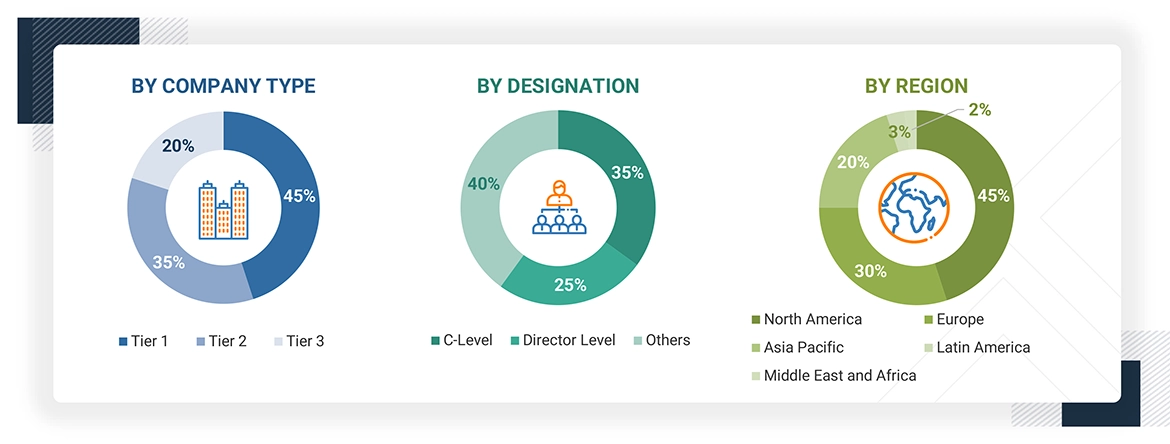The study involved major activities in estimating the current market size for the hospital information systems market. Exhaustive secondary research was done to collect information on the hospital information systems industry. The next step was to validate these findings, assumptions, and sizing with industry experts across the value chain using primary research. Different approaches, such as top-down and bottom-up, were employed to estimate the total market size. After that, the market breakup and data triangulation procedures were used to estimate the market size of the segments and subsegments of the hospital information systems market.
Secondary Research
In the secondary research process, various secondary sources such as annual reports, press releases & investor presentations of companies, white papers, certified publications, articles by recognized authors, gold-standard & silver-standard websites, regulatory bodies, and databases (such as D&B Hoovers, Bloomberg Business, and Factiva) were referred to in order to identify and collect information for the study of hospital information systems market. It was also used to obtain important information about the top players, market classification, and segmentation according to industry trends to the bottom-most level, geographic markets, and key developments related to the market. A database of the key industry leaders was also prepared using secondary research.
Primary Research
Extensive primary research was conducted after acquiring basic knowledge about the global hospital information systems market scenario through secondary research. Several primary interviews were conducted with market experts from both the demand side (Hospital directors, Hospital Vice Presidents, Department heads, and Critical care specialists ) and supply side (such as C-level and D-level executives, technology experts, product managers, marketing and sales managers, among others) across five major regions—North America, Europe, Asia Pacific, Latin America, and Middle East & Africa. This primary data was collected through questionnaires, e-mails, online surveys, personal interviews, and telephonic interviews
The following is a breakdown of the primary respondents:

Note 1: Others include sales, marketing, and product managers.
Note 2: Tiers of companies are defined on the basis of their total revenues in 2023. Tier 1 = >USD 1 billion, Tier 2 = USD 500 million to USD 1 billion, and Tier 3 = < USD 500 million.
To know about the assumptions considered for the study, download the pdf brochure
Market Size Estimation
Both top-down and bottom-up approaches were used to estimate and validate the total size of the hospital information systems market. These methods were also used extensively to estimate the size of various subsegments in the market.
The research methodology used to estimate the market size includes the following:
Data Triangulation
After arriving at the overall market size—using the market size estimation processes—the market was split into several segments and subsegments. To complete the overall market engineering process and arrive at the exact statistics of each market segment and sub-segment, data triangulation and market breakdown procedures were employed, wherever applicable. The data was triangulated by studying various factors and trends from both the demand and supply sides in the hospital information systems market.
Market Definition
The Hospital Information System (HIS) is a comprehensive, integrated software solution market designed to manage and streamline various aspects of hospital operations, encompassing medical, administrative, financial, and legal functions. By consolidating patient health records and hospital processes onto a unified platform, HIS enhances efficiency, reduces errors, and improves the quality of patient care.
Stakeholders
-
Hospital information systems providers
-
Hospital information systems vendors
-
Hospital information systems service providers
-
Healthcare payers
-
Academic research institutes
-
Government institutes
-
Market research and consulting firms
-
Venture capitalists and investors
-
Medical Societies and Professional Associations
-
Consultants and IT Service Providers
-
Technology Vendors and Developers
-
Public Health Agencies
-
Regulatory Bodies and Policymakers
-
Advocacy and Nonprofit Organizations
Report Objectives
-
To define, describe, and forecast the global hospital information systems market based on component, product type, deployment, facility size, and region.
-
To provide detailed information regarding the major factors (such as drivers, restraints, opportunities, and challenges) influencing the market growth
-
To strategically analyze micro-markets with respect to individual growth trends, prospects, and contributions to the overall hospital information systems market
-
To analyze opportunities in the market for stakeholders and provide details of the competitive landscape for market leaders.
-
To strategically analyze the market structure profile of the key players of the hospital information systems market and comprehensively analyze their core competencies.
-
To forecast the size of the market segments with respect to five regions: North America, Europe, Asia Pacific, Latin America, and the Middle East & Africa.
-
To track and analyze competitive developments such as product launches and enhancements and investments, partnerships, collaborations, acquisitions, expansions, product approval, and alliances in the hospital information systems market during the forecast period.



Growth opportunities and latent adjacency in Hospital Information Systems Market